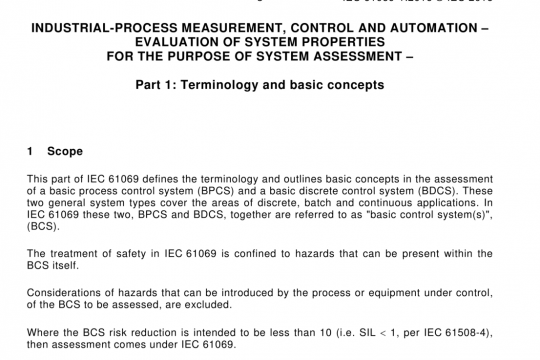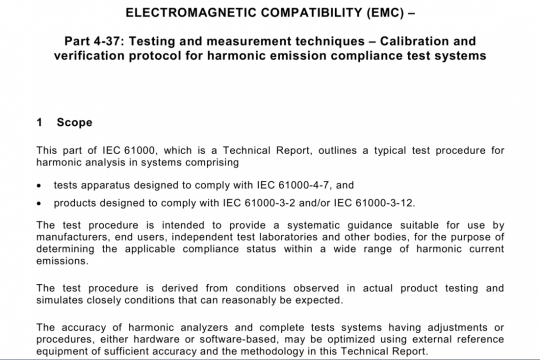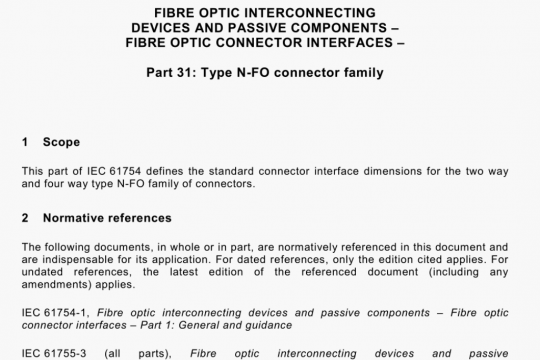IEC 62047-41 pdf free download
IEC 62047-41 pdf free download.Semiconductor devices – Micro-electromechanical devices – Part 41: RF MEMS circulators and isolators.
5.3.4 Precautions to be observed
Isolation L0 shall be measured without the influence at the input and output ports.
5.3.5 Measurement procedure
5.3.5.1 Method A): with the 4-port network analyser, the measurement procedures are as follows:
a) The RF MEMS circulator/isolator should be suitably packaged and mounted on a test fixture;
b) The test fixture, network analyser, cable and connectors should be calibrated before measurement;
c) The test fixture should be connected to the network analyser using the test cable with 50 C) connectors. For circulators, connected as Figure 4; for isolators, connected as Figure 5;
d) The network analyser should be pre-set and set to the standard S-parameters measurement class, where selecting the transmission measurements (S12, s31 and S23):
1) Specify the frequency range of the signal source, which is the span of frequency for making a device measurement, including start frequency, stop frequency, number of measurement points, etc.;
2) Specify the frequency sweep type of the signal source, using linear frequency sweep type typically;
3) Specify the power level of the signal source to proper value;
4) Specify the display format, usually using “Log Mag” display format.
e) Perform measurement:
1) Scale the displayed measurement for optimum viewing;
2) Read the S-parameter (S12, S23, and S31) values. Each parameter values at each frequency point are the isolation: Ljso(12) = S1, L10 = S23 and Ljso(31) = S31.
5.3.5.2 Method B): with the 2-port network analyser, the measurement procedures are as follow:
a) The RF MEMS circulator/isolator should be suitably packaged and mounted on a test fixture;
b) The test fixture, network analyser, cable and connectors should be calibrated before measurement;
C) The test fixture should be connected to the network analyser using the test cable with 50 C) connectors. For circulators, connected as Figure 6 a); for isolators, connected as Figure 7;
d) The network analyser should be pre-set and set to the standard S-parameters measurement class, where selecting the transmission measurements (Si2):
1) Specify the frequency range of the signal source, which is the span of frequency for making a device measurement, including start frequency, stop frequency, number of measurement points, etc.;
2) Specify the frequency sweep type of the signal source, using linear frequency sweep type typically;
3) Specify the power level of the signal source to proper value;
4) Specify the display format, usually using Log Mag” display format.
With 4-port network analysers, the measuring circuit diagram for the return loss measurement of circulators is shown in Figure 4. And the measuring circuit diagram for the return loss measurement of isolators is shown in Figure 5. With 2-port network analysers, the measuring circuit diagram for the return loss measurement of circulators is shown in Figure 6. And the measuring circuit diagram for the return loss measurement of isolators is shown in Figure 7.It is the connection of additional impedance to an existing one in order to accomplish a specific effect, such as to balance a circuit or to reduce reflection in the circulator/isolator. Generally, load impedance is set to 50 n. So, characteristic impedance should be matched to 50 n for the high effective RF transmission. The impedance for the circulator/isolator can be obtained from the measured Smith Chart, the centre point of the Smith Chart is typically 50 n, as shown in Figure 11. For circulators, the impedance can be read from Smith Chart – (S11, S22 and S33); for isolators, the impedance can be read from Smith Chart (S11 and S22). IEC 62047-41 pdf download.




